light TOYOTA C-HR 2020 Warranties & Maintenance Guides (in English)
[x] Cancel search | Manufacturer: TOYOTA, Model Year: 2020, Model line: C-HR, Model: TOYOTA C-HR 2020Pages: 260, PDF Size: 8.54 MB
Page 154 of 260
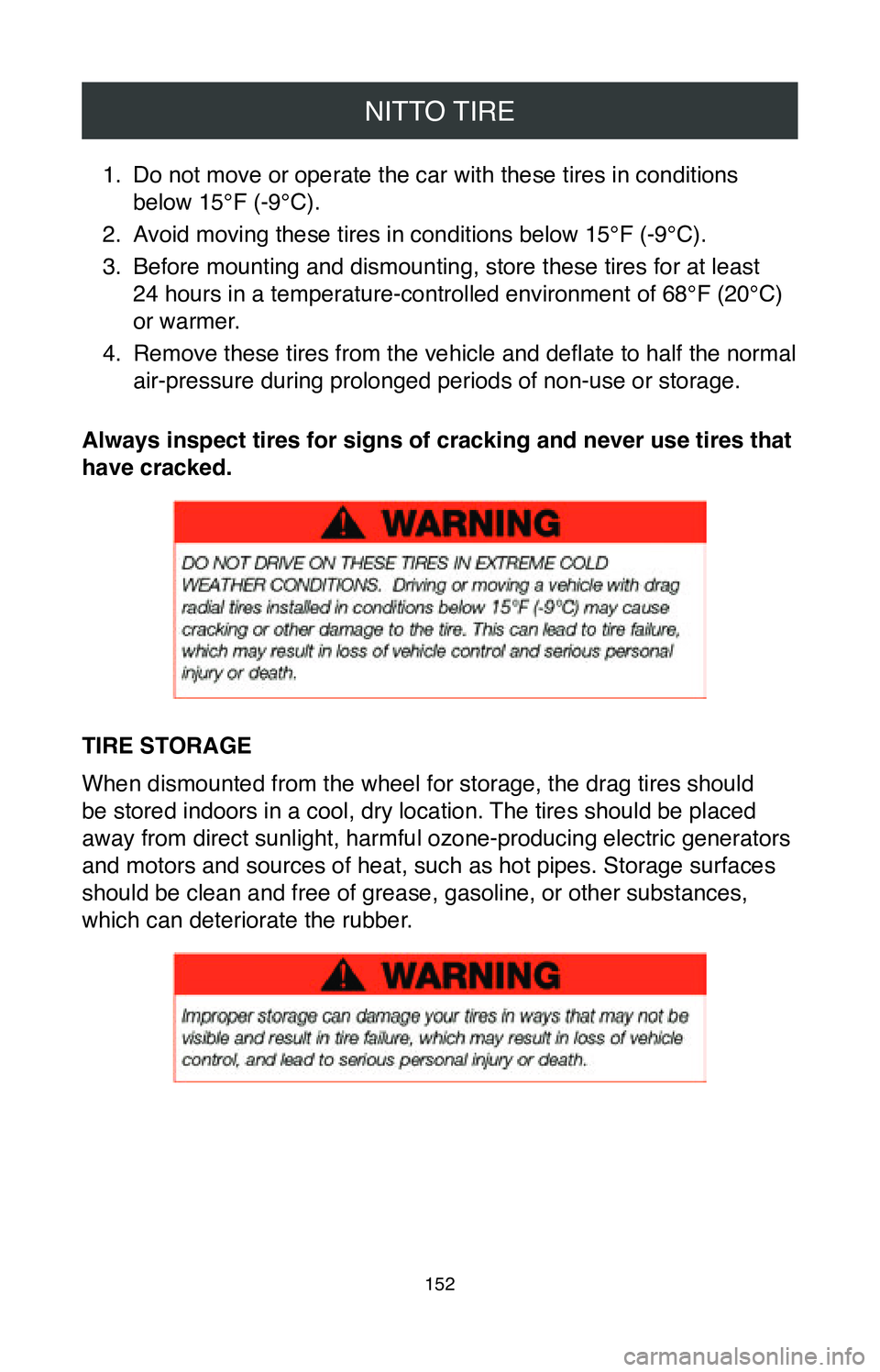
NITTO TIRE
152
1. Do not move or operate the car with these tires in conditions
below 15°F (-9°C).
2.
Avoid moving these tires in conditions below 15°F (-9°C).
3.
Before mounting and dismounting, store these tires for at least
24 hours in a temperature-controlled environment of 68°F (20°C)
or warmer.
4.
Remove these tires from the vehicle and deflate to half the normal
air-pressure during prolonged periods of non-use or storage.
Always inspect tires for signs of cracking and never use tires that
have cracked.
TIRE STORAGE
When dismounted from the wheel for storage, the drag tires should
be stored indoors in a cool, dry location. The tires should be placed
away from direct sunlight, harmful ozone-producing electric generators
and motors and sources of heat, such as hot pipes. Storage surfaces
should be clean and free of grease, gasoline, or other substances,
which can deteriorate the rubber.
Page 165 of 260
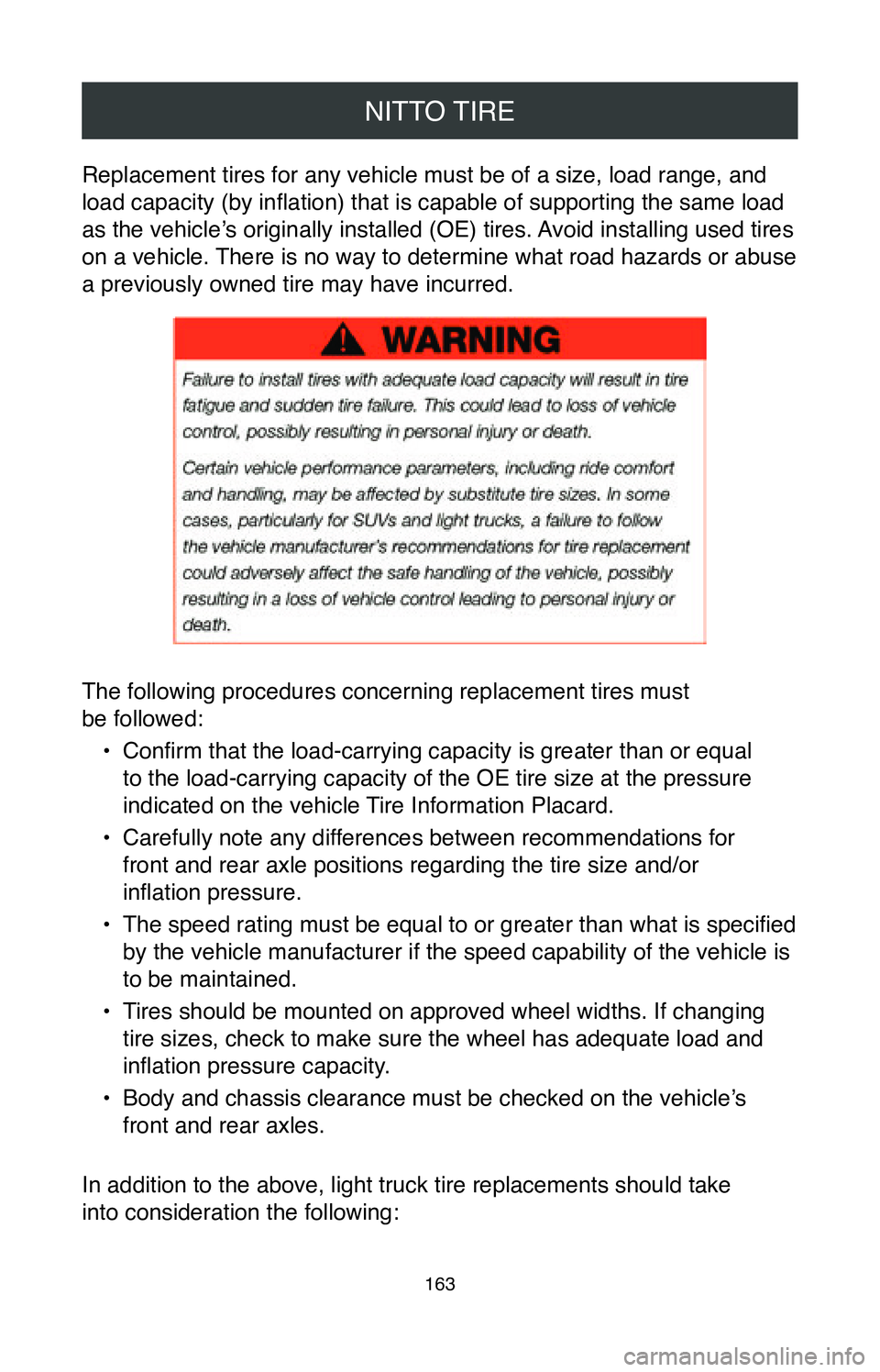
NITTO TIRE
163
Replacement tires for any vehicle must be of a size, load range, and
load capacity (by inflation) that is capable of supporting the same load
as the vehicle’s originally installed (OE) tires. Avoid installing used tires
on a vehicle. There is no way to determine what road hazards or abuse
a previously owned tire may have incurred.
The following procedures concerning replacement tires must
be followed:•
Confirm that the load-carrying capacity is greater than or equal
to the load-carrying capacity of the OE tire size at the pressure
indicated on the vehicle Tire Information Placard.
•
Carefully note any differences between recommendations for
front and rear axle positions regarding the tire size and/or
inflation pressure.
•
The speed rating must be equal to or greater than what is specified
by the vehicle manufacturer if the speed capability of the vehicle is
to be maintained.
•
Tires should be mounted on approved wheel widths. If changing
tire sizes, check to make sure the wheel has adequate load and
inflation pressure capacity.
•
Body and chassis clearance must be checked on the vehicle’s
front and rear axles.
In addition to the above, light truck tire replacements should take
into consideration the following:
Page 166 of 260
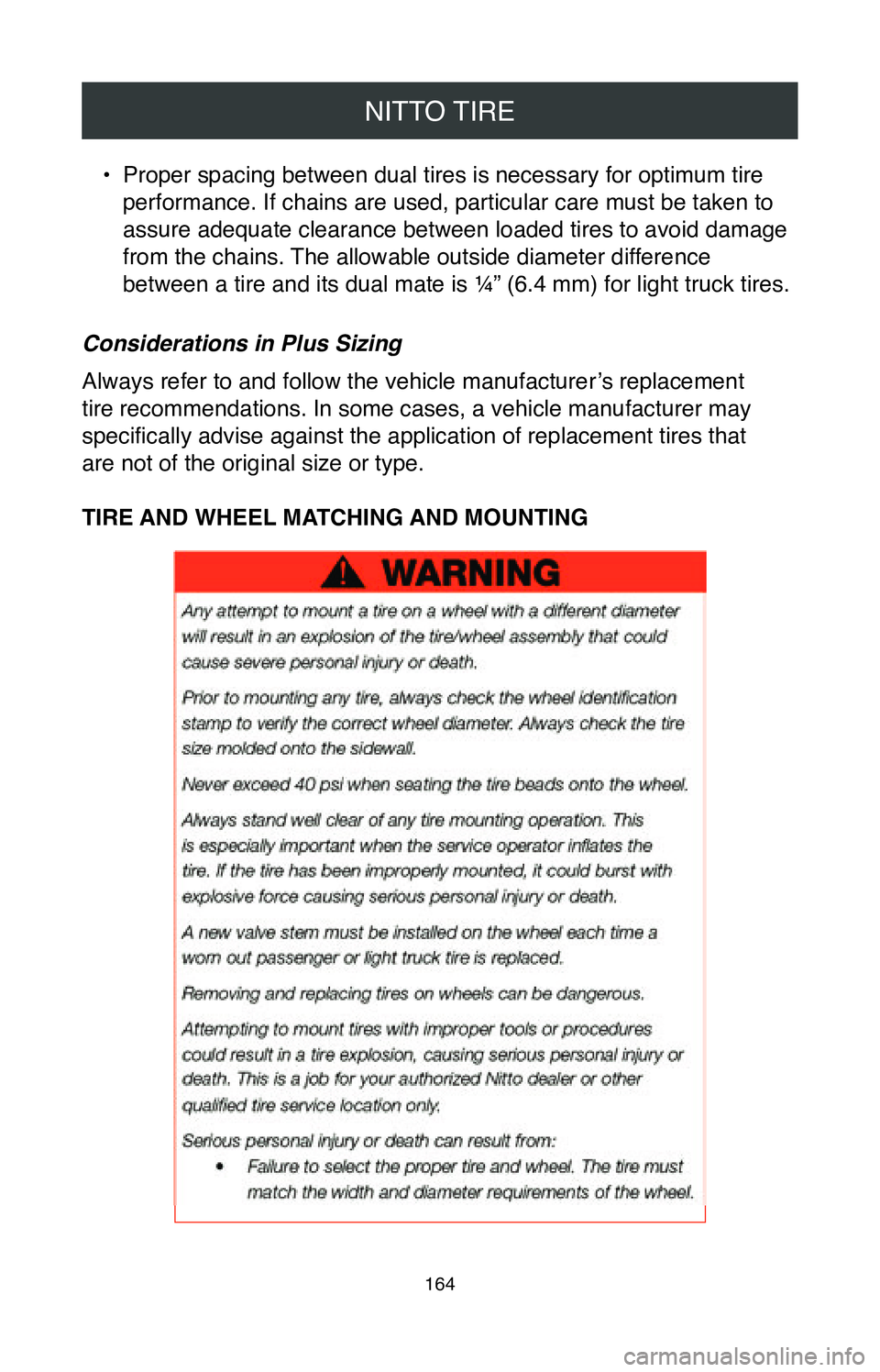
NITTO TIRE
164
• Proper spacing between dual tires is necessary for optimum tire
performance. If chains are used, particular care must be taken to
assure adequate clearance between loaded tires to avoid damage
from the chains. The allowable outside diameter difference
between a tire and its dual mate is ¼” (6.4 mm) for light truck tires.
Considerations in Plus Sizing
Always refer to and follow the vehicle manufacturer’s replacement
tire recommendations. In some cases, a vehicle manufacturer may
specifically advise against the application of replacement tires that
are not of the original size or type.
TIRE AND WHEEL MATCHING AND MOUNTING
Page 168 of 260
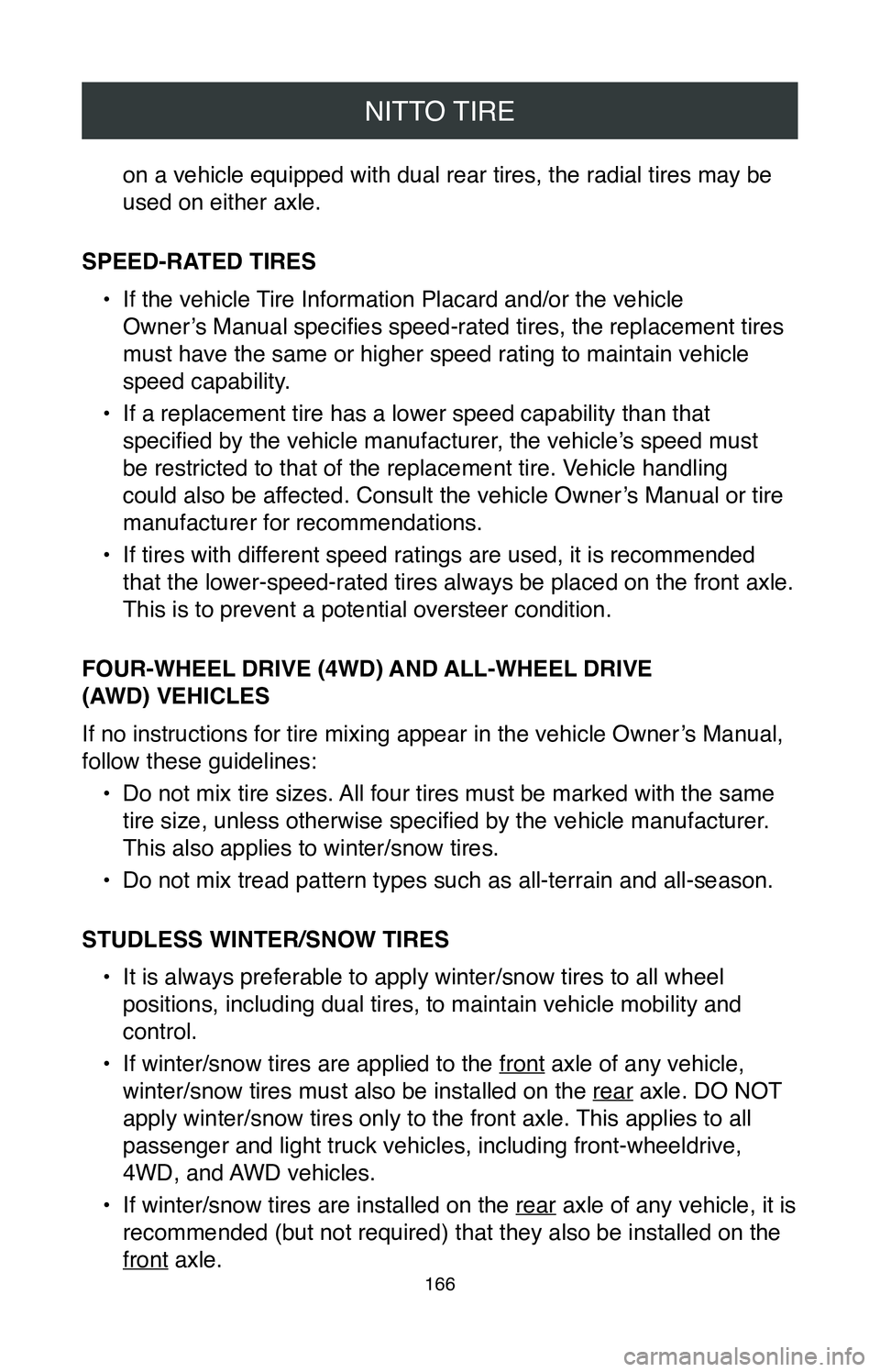
NITTO TIRE
166
on a vehicle equipped with dual rear tires, the radial tires may be
used on either axle.
SPEED-RATED TIRES •
If the vehicle Tire Information Placard and/or the vehicle
Owner’s Manual specifies speed-rated tires, the replacement tires
must have the same or higher speed rating to maintain vehicle
speed capability.
•
If a replacement tire has a lower speed capability than that
specified by the vehicle manufacturer, the vehicle’s speed must
be restricted to that of the replacement tire. Vehicle handling
could also be affected. Consult the vehicle Owner’s Manual or tire
manufacturer for recommendations.
•
If tires with different speed ratings are used, it is recommended
that the lower-speed-rated tires always be placed on the front axle.
This is to prevent a potential oversteer condition.
FOUR-WHEEL DRIVE (4WD) AND ALL-WHEEL DRIVE
(AWD) VEHICLES
If no instructions for tire mixing appear in the vehicle Owner’s Manual,
follow these guidelines: •
Do not mix tire sizes. All four tires must be marked with the same
tire size, unless otherwise specified by the vehicle manufacturer .
This also applies to winter/snow tires.
•
Do not mix tread pattern types such as all-terrain and all-season.
STUDLESS WINTER/SNOW TIRES •
It is always preferable to apply winter/snow tires to all wheel
positions, including dual tires, to maintain vehicle mobility and
control.
•
If winter/snow tires are applied to the front axle of any vehicle,
winter/snow tires must also be installed on the rear axle. DO NOT
apply winter/snow tires only to the front axle. This applies to all
passenger and light truck vehicles, including front-wheeldrive,
4WD, and AWD vehicles.
•
If winter/snow tires are installed on the rear axle of any vehicle, it is
recommended (but not required) that they also be installed on the
front axle.
Page 172 of 260
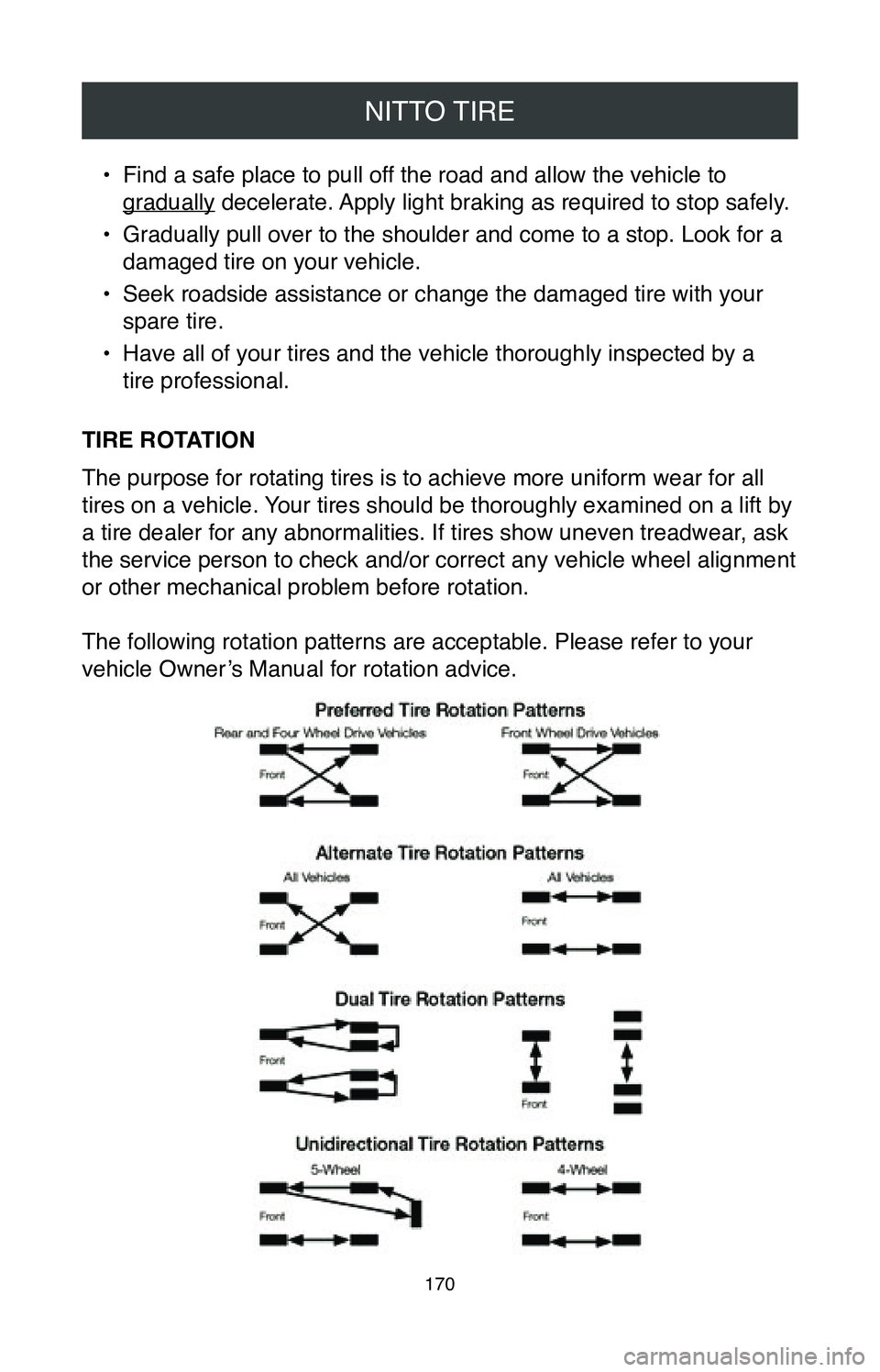
NITTO TIRE
170
• Find a safe place to pull off the road and allow the vehicle to
gradually decelerate. Apply light braking as required to stop safely.
•
Gradually pull over to the shoulder and come to a stop. Look for a
damaged tire on your vehicle.
•
Seek roadside assistance or change the damaged tire with your
spare tire.
•
Have all of your tires and the vehicle thoroughly inspected by a
tire professional.
TIRE ROTATION
The purpose for rotating tires is to achieve more uniform wear for all
tires on a vehicle. Your tires should be thoroughly examined on a lift by
a tire dealer for any abnormalities. If tires show uneven treadwear, ask
the service person to check and/or correct any vehicle wheel alignment
or other mechanical problem before rotation.
The following rotation patterns are acceptable. Please refer to your
vehicle Owner’s Manual for rotation advice.
Page 173 of 260
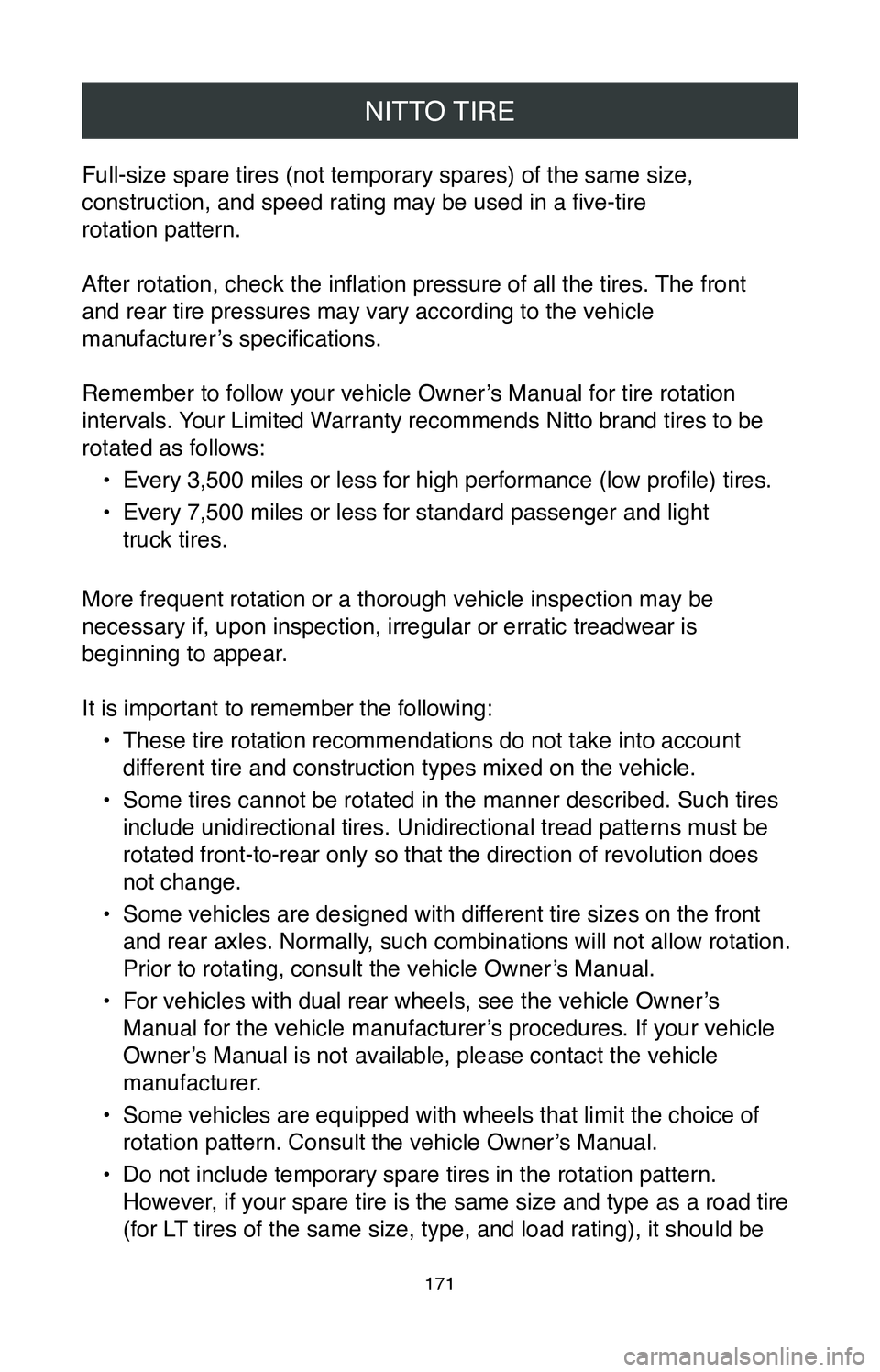
NITTO TIRE
171
Full-size spare tires (not temporary spares) of the same size,
construction, and speed rating may be used in a five-tire
rotation pattern.
After rotation, check the inflation pressure of all the tires. The front
and rear tire pressures may vary according to the vehicle
manufacturer’s specifications.
Remember to follow your vehicle Owner’s Manual for tire rotation
intervals. Your Limited Warranty recommends Nitto brand tires to be
rotated as follows:
•
Every 3,500 miles or less for high performance (low profile) tires.
•
Every 7,500 miles or less for standard passenger and light
truck tires.
More frequent rotation or a thorough vehicle inspection may be
necessary if, upon inspection, irregular or erratic treadwear is
beginning to appear.
It is important to remember the following: •
These tire rotation recommendations do not take into account
different tire and construction types mixed on the vehicle.
•
Some tires cannot be rotated in the manner described. Such tires
include unidirectional tires. Unidirectional tread patterns must be
rotated front-to-rear only so that the direction of revolution does
not change.
•
Some vehicles are designed with different tire sizes on the front
and rear axles. Normally, such combinations will not allow rotation.
Prior to rotating, consult the vehicle Owner’s Manual.
•
For vehicles with dual rear wheels, see the vehicle Owner’s
Manual for the vehicle manufacturer’s procedures. If your vehicle
Owner’s Manual is not available, please contact the vehicle
manufacturer.
•
Some vehicles are equipped with wheels that limit the choice of
rotation pattern. Consult the vehicle Owner’s Manual.
•
Do not include temporary spare tires in the rotation pattern.
However, if your spare tire is the same size and type as a road tire
(for LT tires of the same size, type, and load rating), it should be
Page 174 of 260
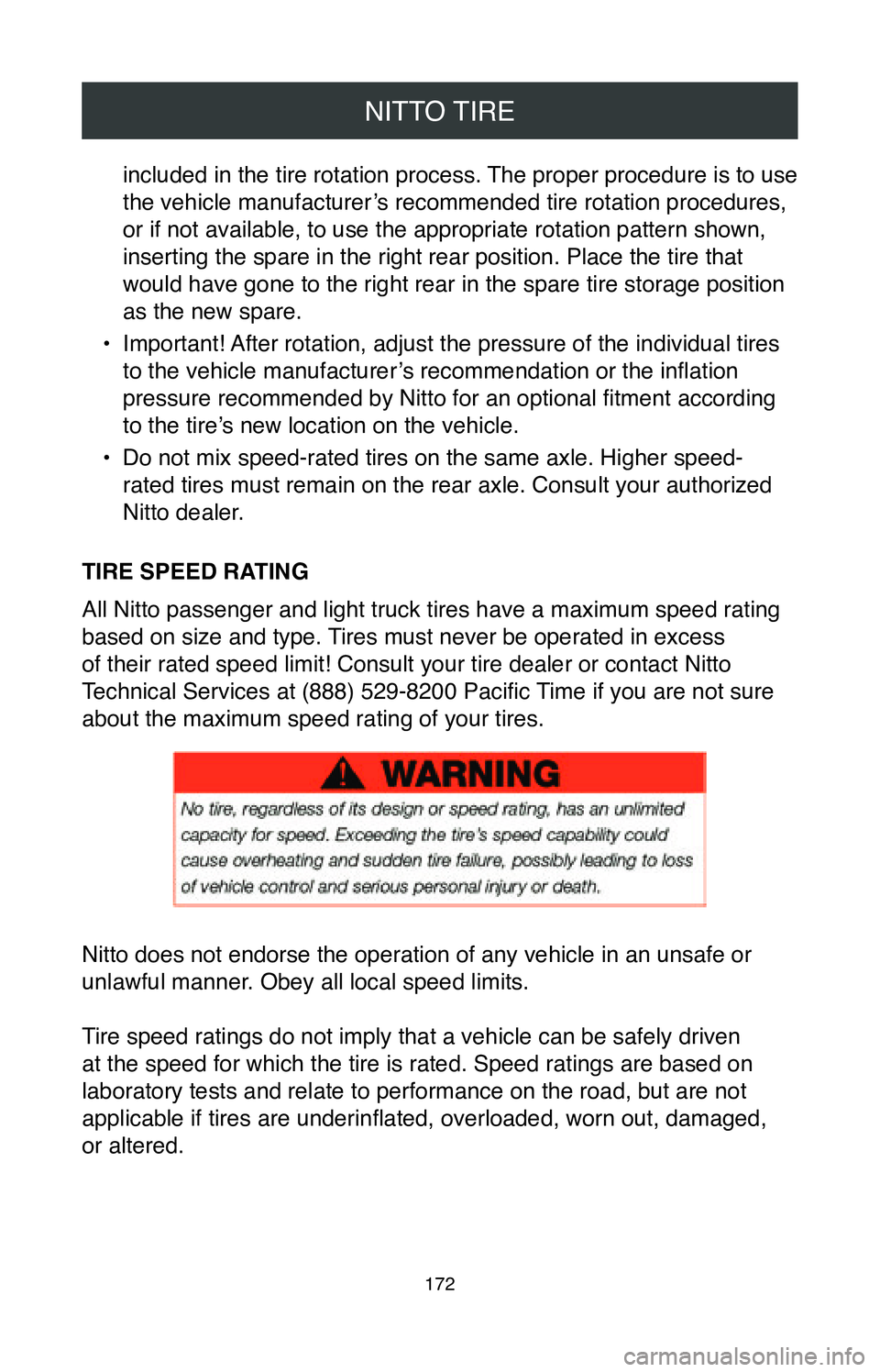
NITTO TIRE
172
included in the tire rotation process. The proper procedure is to use
the vehicle manufacturer’s recommended tire rotation procedures,
or if not available, to use the appropriate rotation pattern shown,
inserting the spare in the right rear position. Place the tire that
would have gone to the right rear in the spare tire storage position
as the new spare.
•
Important! After rotation, adjust the pressure of the individual tires
to the vehicle manufacturer’s recommendation or the inflation
pressure recommended by Nitto for an optional fitment according
to the tire’s new location on the vehicle.
•
Do not mix speed-rated tires on the same axle. Higher speed-
rated tires must remain on the rear axle. Consult your authorized
Nitto dealer.
TIRE SPEED RATING
All Nitto passenger and light truck tires have a maximum speed rating
based on size and type. Tires must never be operated in excess
of their rated speed limit! Consult your tire dealer or contact Nitto
Technical Services at (888) 529-8200 Pacific Time if you are not sure
about the maximum speed rating of your tires.
Nitto does not endorse the operation of any vehicle in an unsafe or
unlawful manner. Obey all local speed limits.
Tire speed ratings do not imply that a vehicle can be safely driven
at the speed for which the tire is rated. Speed ratings are based on
laboratory tests and relate to performance on the road, but are not
applicable if tires are underinflated, overloaded, worn out, damaged,
or altered.
Page 181 of 260
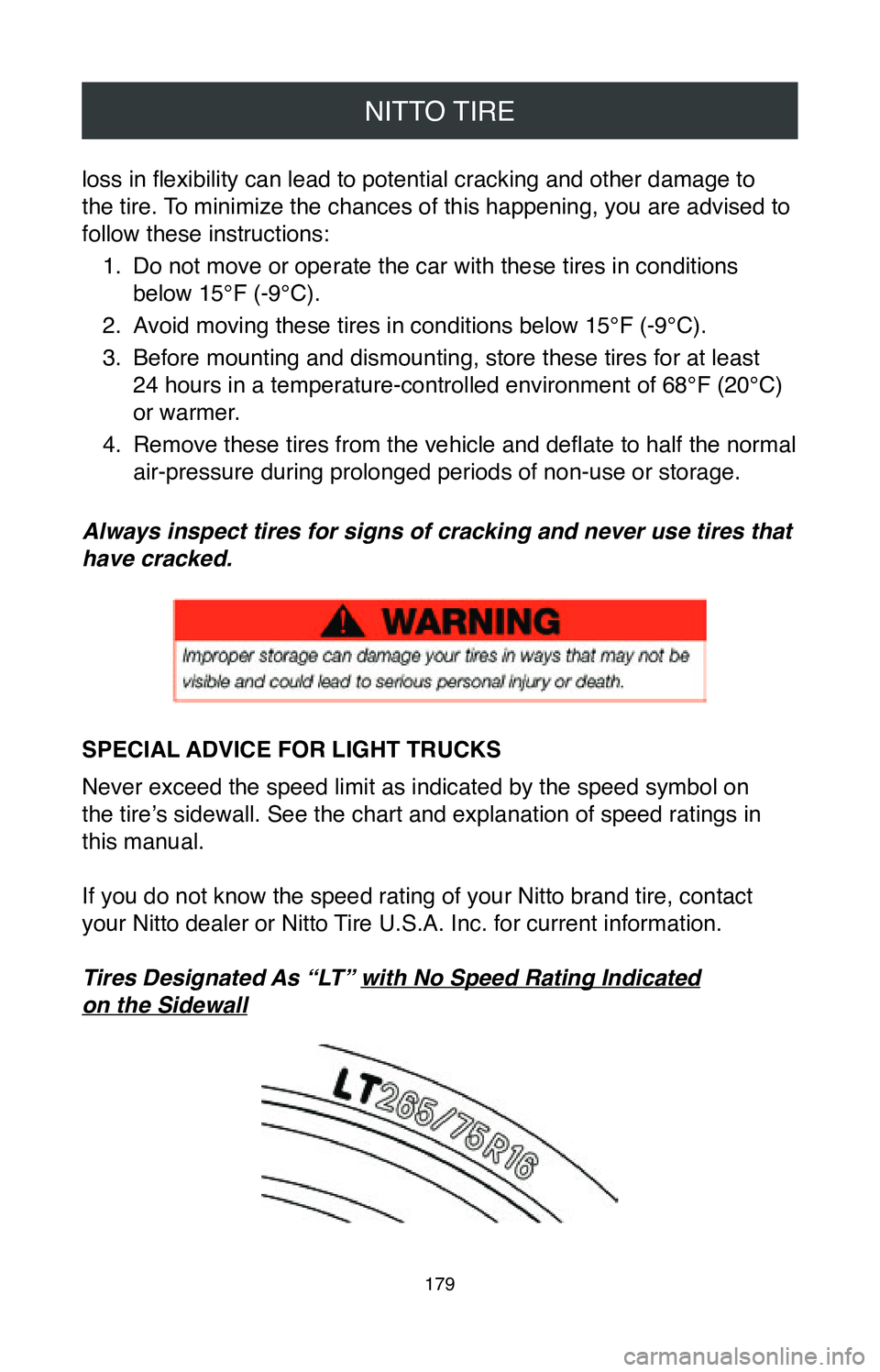
NITTO TIRE
179
loss in flexibility can lead to potential cracking and other damage to
the tire. To minimize the chances of this happening, you are advised to
follow these instructions:1.
Do not move or operate the car with these tires in conditions
below 15°F (-9°C).
2.
Avoid moving these tires in conditions below 15°F (-9°C).
3.
Before mounting and dismounting, store these tires for at least
24 hours in a temperature-controlled environment of 68°F (20°C)
or warmer.
4.
Remove these tires from the vehicle and deflate to half the normal
air-pressure during prolonged periods of non-use or storage.
Always inspect tires for signs of cracking and never use tires that
have cracked.
SPECIAL ADVICE FOR LIGHT TRUCKS
Never exceed the speed limit as indicated by the speed symbol on
the tire’s sidewall. See the chart and explanation of speed ratings in
this manual.
If you do not know the speed rating of your Nitto brand tire, contact
your Nitto dealer or Nitto Tire U.S.A. Inc. for current information.
Tires Designated As “LT” with No Speed Rating Indicated
on the Sidewall
Page 182 of 260
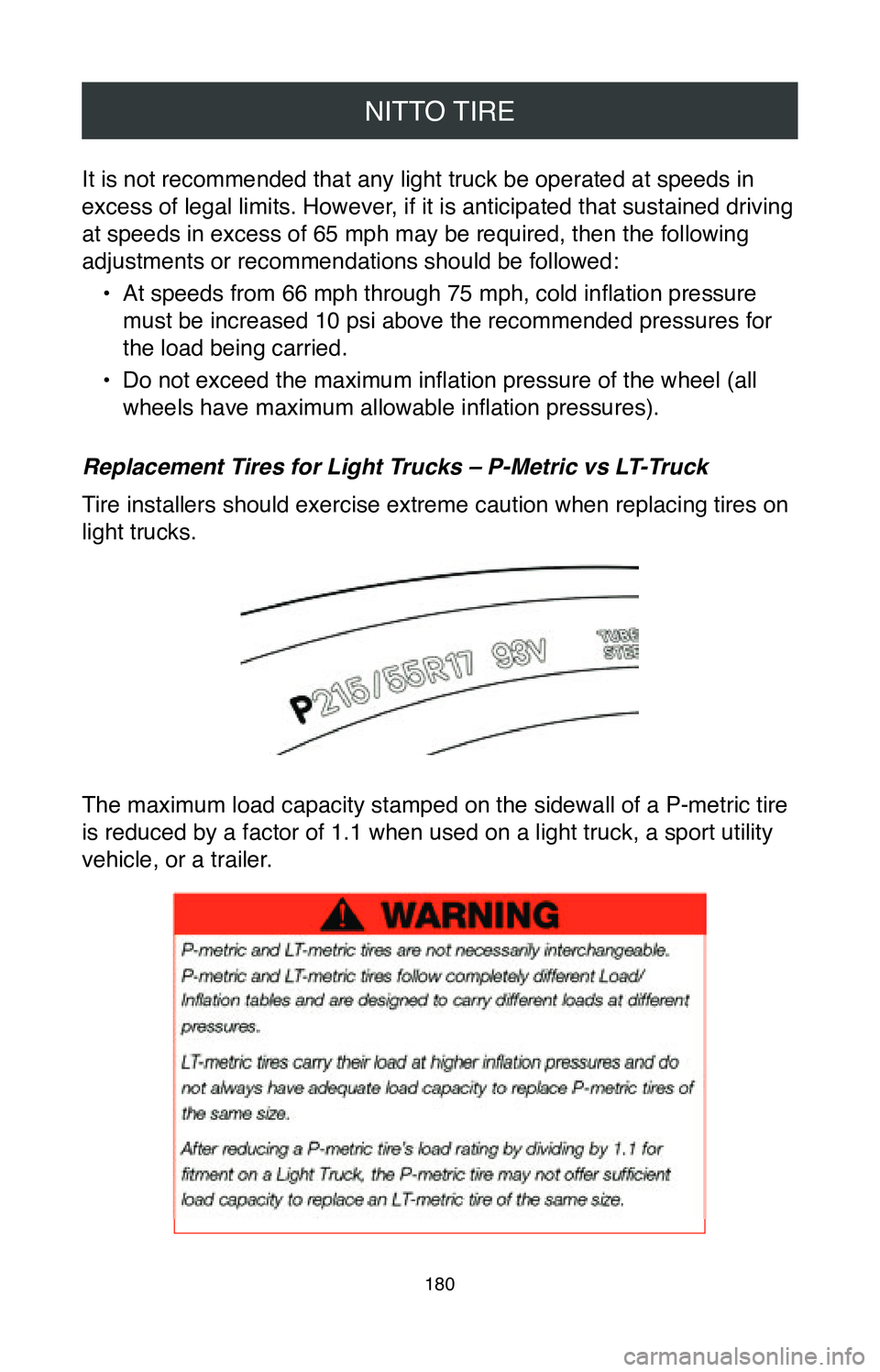
NITTO TIRE
180
It is not recommended that any light truck be operated at speeds in
excess of legal limits. However, if it is anticipated that sustained driving
at speeds in excess of 65 mph may be required, then the following
adjustments or recommendations should be followed:•
At speeds from 66 mph through 75 mph, cold inflation pressure
must be increased 10 psi above the recommended pressures for
the load being carried.
•
Do not exceed the maximum inflation pressure of the wheel (all
wheels have maximum allowable inflation pressures).
Replacement Tires for Light Trucks – P-Metric vs LT-Truck
Tire installers should exercise extreme caution when replacing tires on
light trucks.
The maximum load capacity stamped on the sidewall of a P-metric tire
is reduced by a factor of 1.1 when used on a light truck, a sport utilit\
y
vehicle, or a trailer.
Page 183 of 260
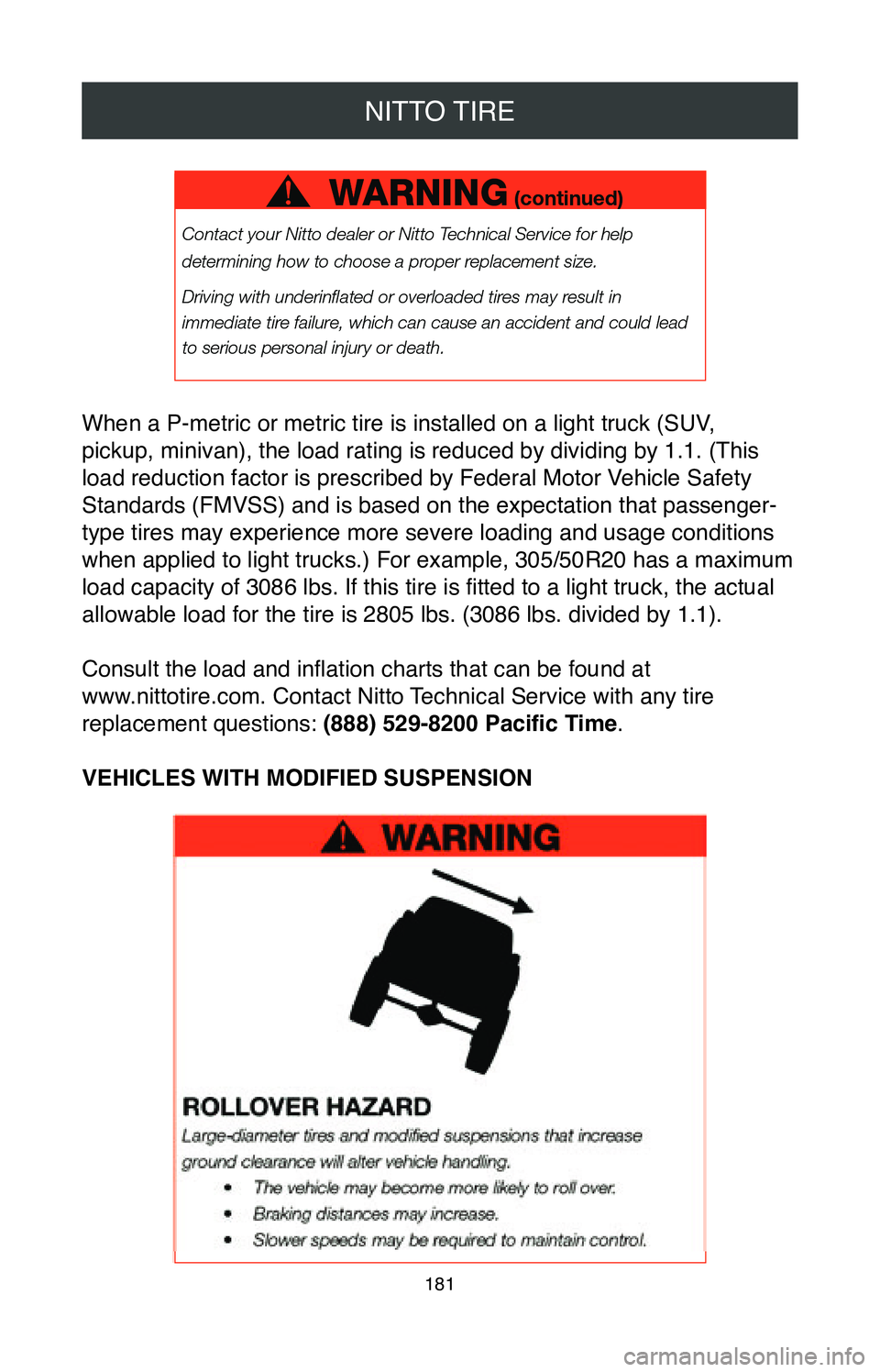
NITTO TIRE
181
When a P-metric or metric tire is installed on a light truck (SUV,
pickup, minivan), the load rating is reduced by dividing by 1.1. (This
load reduction factor is prescribed by Federal Motor Vehicle Safety
Standards (FMVSS) and is based on the expectation that passenger-
type tires may experience more severe loading and usage conditions
when applied to light trucks.) For example, 305/50R20 has a maximum
load capacity of 3086 lbs. If this tire is fitted to a light truck, the actual
allowable load for the tire is 2805 lbs. (3086 lbs. divided by 1.1).
Consult the load and inflation charts that can be found at
www.nittotire.com. Contact Nitto Technical Service with any tire
replacement questions: (888) 529-8200 Pacific Time.
VEHICLES WITH MODIFIED SUSPENSION